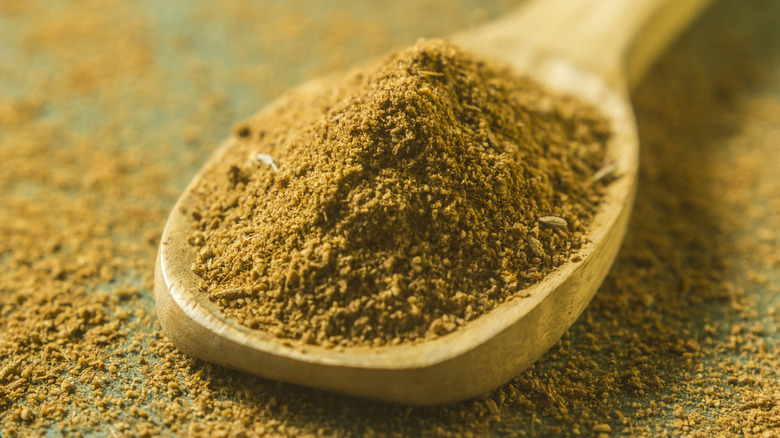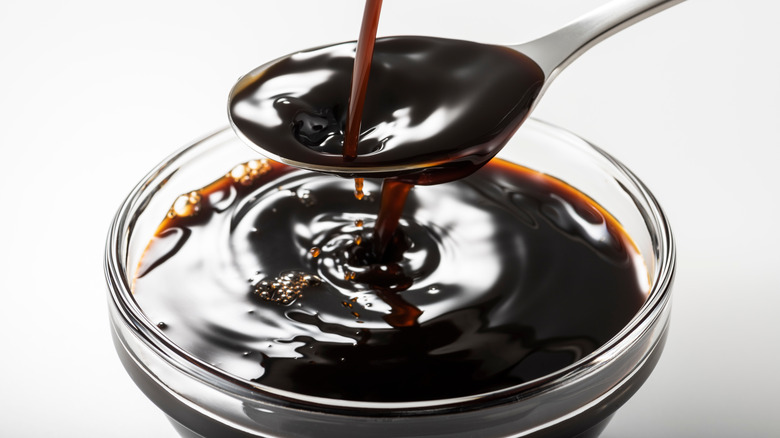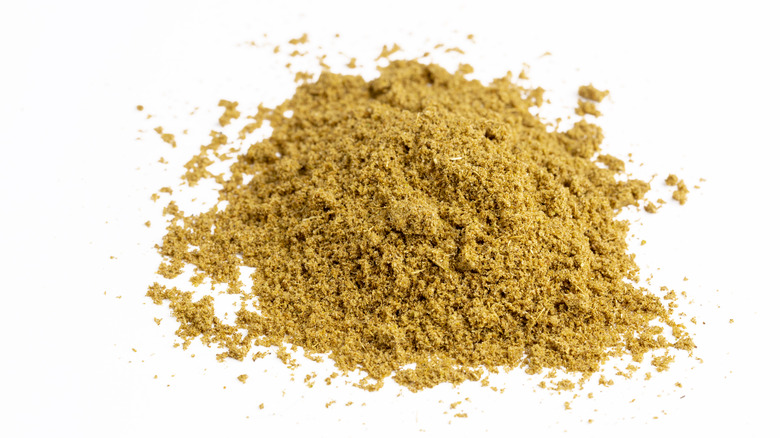Worcestershire Powder Is The Overlooked Addition For Flavorful Dry Rubs
Here at Tasting Table, we're all about uncommon seasonings. After all, the proverbial "spice of life" might actually just be literal cooking spices. That's why we're deep-diving into one unusual seasoning that, despite its non-celebrity stats, definitely deserves a spot in your cabinet. Introducing Worcestershire powder: the tangy, savory creation of your wildest umami dreams.
So, where did it get its start? Worcestershire sauce was named after the eponymous town in England where it was invented and first sold — although, the origin story changes depending on who you ask. Worcestershire sauce might have been created in Bengal, then adopted by an English traveler, who brought it back home with him and reverse-engineered the ingredients.
Texas' David Wade is credited with first converting the beloved sauce into powder form. He was one of America's first celebrity chefs, garnering popularity in the '50s and '60s for his cooking show series. Wade's name didn't become a lasting mark on the map for his shows, but for his signature spice, the "Original Worcestershire Powder," which continues to be sold today.
Add a meaty kick to your recipes
As its name implies, Worcestershire powder is essentially a dried version of the liquid sauce. Fittingly, it's made from largely the same lineup of ingredients, which, according to Firehouse Pantry Store, is some mixture of garlic, sugar, maltodextrin, an undisclosed blend of spices, and "soy sauce solids." But, the dried tamarind and vinegar powder perhaps speak loudest in the seasoning's profile. Liquid Worcestershire sauce, for comparison, is typically some aged combination of tamarind, molasses, garlic, vinegar, chilis, onion, chives, cloves, tomato concentrate, and sugar.
You can pretty much use Worcestershire powder anywhere you'd use the sauce but with all the added benefits of its dry form. Use it as a rub or marinade for steak, chicken, pork chops, or seafood. Stir it into Bloody Marys and cocktail sauce or season popcorn with it. Worcestershire powder can elevate gravy, shepherd's pie, chili, and even canned tomato soup. (Bonus point is you dip a fittingly-savory bacon grilled cheese sandwich in it.)
Stir it into a savory chip dip with sour cream and cream cheese, the same way you might use ranch dressing powder. And if you own a dehydrator, Worcestershire powder is about to be your new BFF for homemade beef jerky. Use it in steak tartare, or for vegetarian foodies, add a kick to tomato tartare. Worcestershire powder imparts a "meaty" taste without the meat, which can make it a great seasoning for plant-based eaters. In this case, use it to season roasted veggies or make a smoky tofu brine.
Advantages over liquid Worcestershire sauce
You can actually hydrate Worcestershire powder into the Worcestershire sauce foodies know and love. Just combine 20% powder, 30% vinegar, and 50% water. In this way, the powder can be an excellent staple dry good to keep on hand for plan-ahead easy access, like a powdered soup mix or instant mashed potatoes.
Stored in an airtight container out of direct light, it has a shelf life of two years or even longer. That's substantially longer than an opened bottle of liquid Worcestershire sauce, which can go bad in just 18 months, even in the fridge. Plus, unlike liquid Worcestershire sauce, which needs to be refrigerated after opening, Worcestershire powder actually fares better at room temp in the pantry. This can be an especially big plus if you have a roommate (or four) with whom you share a refrigerator.
From a culinary standpoint, the powdered spice also won't affect the texture or moisture of your recipes. For instance, if you're going for a crispy panko bread crumb fry on your tofu, logging it down with a bunch of wet liquid Worcestershire sauce probably isn't the move. However, toss those breadcrumbs in some Worcestershire powder and you've got a crispy, savory breading built to please, sogginess-free.
Where to get your paws on the powder
In a delicious full-circle moment for the humble seasoning, foodies can order David Wade's Original Worcestershire Powder online. A 4-ounce bag runs for $9.95, and more devoted umami aficionados can get a "case" of the stuff for $95.88 that includes twelve 4-ounce packs. Or, a gourmet variety by Hoosier Hill Farm will set you back $23.99 for a 1.5-pound bulk container. If you'd rather start small to try it out, a 2.47-ounce jar costs just $3.68 via Firehouse Pantry Store. This version by the Great American Spice Company doesn't contain any anchovy powder, so it's a good fit for vegan foodies.
One interesting part about Worcestershire powder is its customizability. If you'd rather make your own blend than buy a premade version, you can switch up the amounts of different ingredients to suit your taste. Play around with combinations of onion powder, ground cloves, chili powder, garlic powder, black pepper, sugar, and beef bouillon. Some of the ingredients admittedly might be a little tougher to find, like dried anchovies, tamarind powder, and vinegar powder — but, luckily, there are plenty of store-bought versions available for purchase if you'd like a jumping-off point to get started.



